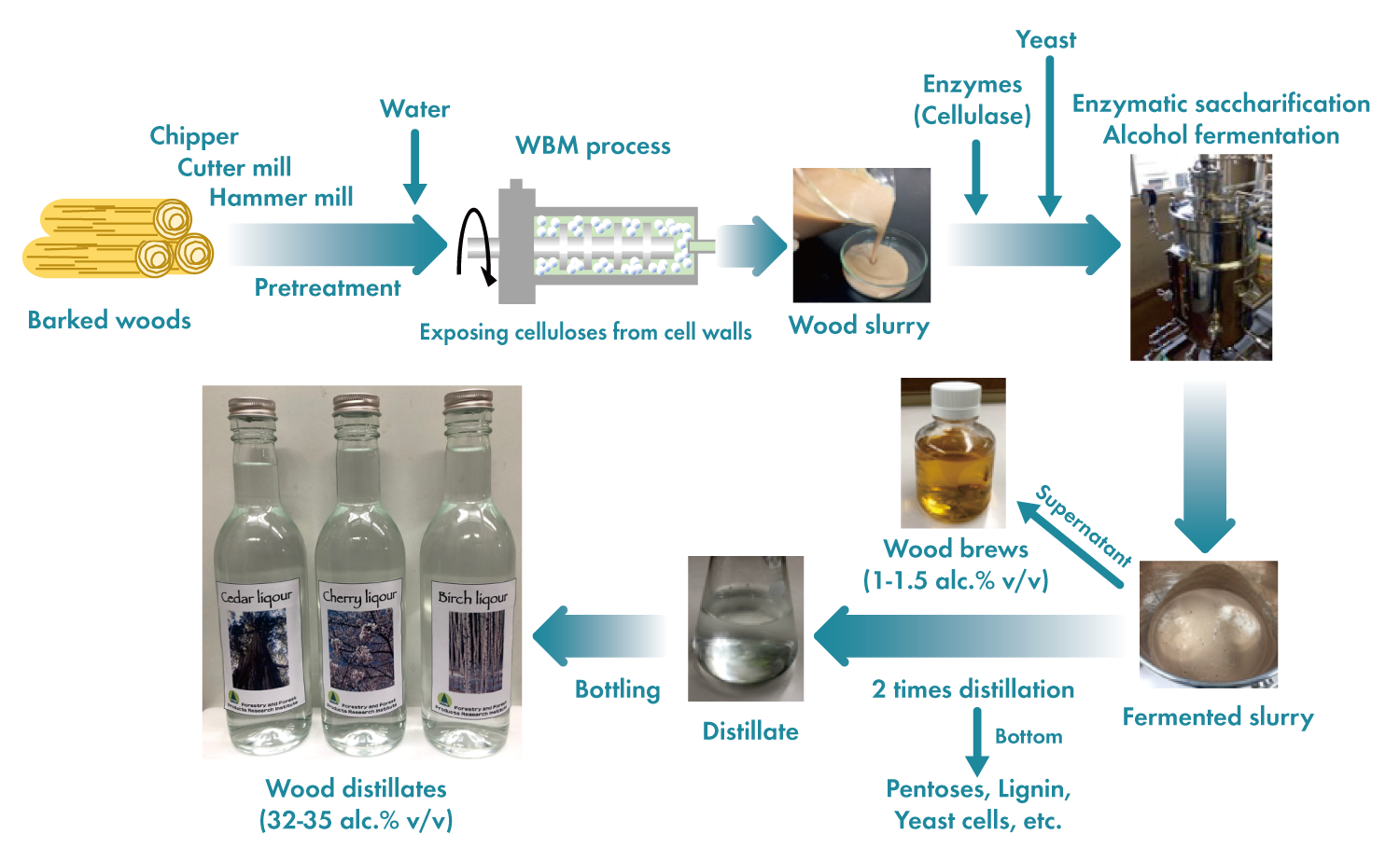INDEX
July 2021
Fragrant Alcoholic Drinks Made from Wood

Technology is being developed to ferment drinking alcohols from wood. Once the safety of drinking such alcohols has been confirmed, it may become possible to commercialize alcoholic beverages characterized by the diverse woody fragrances of trees found across Japan.
The Forestry and Forest Products Research Institute, Forest Research and Management Organization (Tsukuba City, Ibaraki Prefecture) is developing technology to produce richly fragrant drinking alcohols with distinctly woody tones using wood as the raw material. The background to the development is a slump in wood prices and the issue of how to efficiently use wood not suited for construction. The research is being conducted as part of measures to utilize forest resources for regional economic revitalization, including resolving the aforementioned issues by promoting new industries in mountain village areas and creating jobs.
Initially, the goal of the research was to develop technology for producing methane gas fuel and bioethanol from wood. Bioethanol is alcohol used for fuel that is made from wood through chemical and heat treatment with sodium hydroxide. Drinking alcohols are made by yeast fermentation of the sugar content of cereals and fruits. Although about half of the content of wood is cellulose, a carbohydrate that also contains sugar, the cellulose is stiffened by a substance called lignin and packed in the cell walls. Normally, therefore, chemical or heat treatment is needed to break down the cell walls, which renders the alcohol produced unsuitable for drinking and only suitable for use as fuel.
The research team sought to newly develop a technique called “wet-type milling” that does not require chemical or heat treatment of the wood. Wood powder and water are mixed and thrown into a high-speed rotary machine called a “bead mill” that is used for food processing. The mill pulverizes the wood on the nano level (pieces smaller than 1/1000th of a millimeter) and successfully exposes the cellulose packed in cell walls without using chemical or heat treatment.
Otsuka Yuichiro of the Forest Research and Management Organization team explains, “Using this technology, we can expose cellulose stiffened by lignin by breaking down the cell walls and making it edible for microorganisms. This means it can be saccharified and fermented. In the beginning, we fermented methane and alcohol from wood, making many attempts at producing methane gas fuel and bioethanol from wood.”
After adding food additive enzymes and yeast to the cream-like substance that emerges from the wet-type milling and letting it ferment for two to four days in a tank, an amber-colored solution was produced with an alcohol content of about 2%. Distilling this fermented solution yielded distillate with an alcohol content of 28–30% that gave off an aromatic fragrance characteristic of the wood used.
It was then that they had an idea. Could this method be used to make alcoholic beverages?
Otsuka says, “With the wet-type milling, the machine was one used in food processing and all the ingredients added were food additives. So we thought, wood fermentation could open up a new field other than energy production. As a result, we took on the challenge of trialing the production of alcohol richly fragrant with woody tones, and we succeeded. If we use cedar lumber with a diameter of 30 cm and a length of 4 m, we can make fifty bottles of ‘wood distillate’ (750 ml) with an alcohol content of 35%.”
There was a fresh fragrance peculiar to cedar coming from the distillate of the fermented cedar. When the researchers tried again with white birch, they created alcohol with a sweet and deeply mellow fragrance. Analysis of these odorants has revealed that they contain the kind of maturation aromatics produced in whiskey and brandy during long cask maturation.
Additionally, the researchers have experimented with cherry, Mongolian oak and kuromoji (Lindera umbellata), and potential has emerged for regional specialties with their own flavors and fragrances.
Nojiri Masanobu of the research team has high hopes for the technology.
“It’s said that we have 1,200 types of trees in Japan. If we can realize technology to make delicious alcohol from trees, then we’ll have new regional alcoholic drinks made from trees characteristic of different areas around Japan. Future research might identify new beneficial components. If we can create local specialties with high added value, that can hopefully promote domestic forestry.”
If this alcoholic beverage made from wood is commercialized, it would be the world’s first. Already, there has been a steady stream of inquiries about the production method from brewers and distillers. The technology is still in the trial stage (as of July 2021), but it is thought that production will accelerate and sales will begin once it is has been confirmed that alcohol brewed from wood is safe to drink. A time might eventually arrive when not only rice sake but also Japan’s new woody alcoholic beverages are enjoyed around the world.


